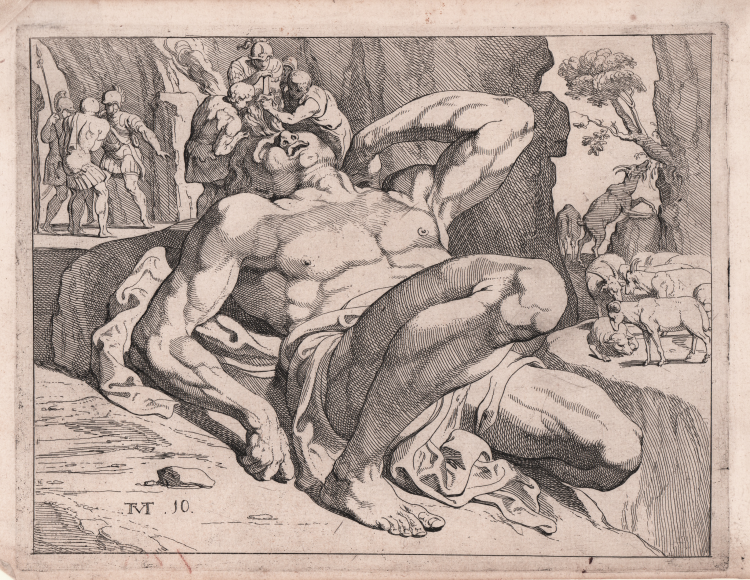



| Reference: | S35328 |
| Author | Theodoor van Thulden |
| Year: | 1633 |
| Measures: | 258 x 195 mm |


| Reference: | S35328 |
| Author | Theodoor van Thulden |
| Year: | 1633 |
| Measures: | 258 x 195 mm |
Ulysses and two companions blinding Polyphemus with a stake
Etching, 1633, after Primaticcio and Niccolò dell' Abbate.
Example of the first state of two, before the addres of François Langlois.
A fine impression, printed on contemporary laid paper, very good condition.
This plate belong to Les travaux d'Ulysse, a series of fifty-eight plates representing the works of Ulysses, after the frescoes designed by Primaticcio and painted by Niccolò dell' Abate for the walls of the Gallery of Ulysses, in Fontainebleau (c.1555-1560). The set was first published in 1633; a later edition, published in 1640 with the address A Paris chez François Langlois, dit Chartres, rüe sainct Jacques,aux colonnes d'Hercules, proche le Lyon d'argent.
The preparatory drawings are now in the Albertina, Vienna. These drawings, the plates and some literary descriptions are the main sources of information we have on the Galerie d'Ulysse, which is now destroyed.
Bibliographic references
Sylvie Béguin and others, "La Galerie d'Ulysse à Fontainebleau", Paris, 1985, notably pp.78-80; Hollstein / Dutch and Flemish etchings, engravings and woodcuts c.1450-1700 (48).
Theodoor van Thulden (Bois-Le-Duc, 1606 - 1669)
|
Theodoor van Thulden ('s-Hertogenbosch, August 9, 1606 - 's-Hertogenbosch, July 12, 1669) was a painter, draughtsman and engraver. He belonged to a Catholic bourgeois family in Oirschot near 's-Hertogenbosch; he was apprenticed to Abraham van Blijenberch and in 1626 was enrolled as a master in Antwerp. He trained possibly with Rubens, by whose style he was already strongly influenced when he painted in Paris for the Trinitarians the Scenes from the Life of St. John of Matha, works executed between 1632 and 1634 and now lost. Also in Paris he published two collections of engravings from Primaticcio's frescoes at Fontainbleau. Returning to Antwerp, in 1635 he worked with Rubens on the city decoration for the entrance of the Cardinal Infante, for which he also executed engravings. Later in 1636 he worked on the decoration of the Torre de la Parada. Stricken by family and economic troubles, he left Antwerp in 1643 to settle in Oirschot and then in 's-Hertogenbosch, where he remained until his death in 1669. There he produced, between 1648 and 1651, his large compositions for the Huis ten Bosch in The Hague, as well as, in 1656, the cartoons for the stained-glass windows for the Cathedral of St. Gudula in Brussels. He painted various religious scenes, including Christ at the Pillar and Flemish Provinces Honor the Virgin Mary of 1654, now in Vienna; he also painted numerous allegorical and mythological scenes, some 40 of which are signed and dated, such as Perseus frees Andromeda of 1664, now in the Museum of Fine Arts in Nancy, and Music and Love in the Royal Museums of Art and History in Brussels, where he attempts with some awkwardness to imitate Antoon van Dyck. As a draughtsman, he shows that he is mainly attracted to the mannerism of the early Fontainebleau school.
His refined production, mainly inspired by Peter Paul Rubens, but at the same time well balanced with his knowledge of Italian models, Titianesque in particular.
|
Theodoor van Thulden (Bois-Le-Duc, 1606 - 1669)
|
Theodoor van Thulden ('s-Hertogenbosch, August 9, 1606 - 's-Hertogenbosch, July 12, 1669) was a painter, draughtsman and engraver. He belonged to a Catholic bourgeois family in Oirschot near 's-Hertogenbosch; he was apprenticed to Abraham van Blijenberch and in 1626 was enrolled as a master in Antwerp. He trained possibly with Rubens, by whose style he was already strongly influenced when he painted in Paris for the Trinitarians the Scenes from the Life of St. John of Matha, works executed between 1632 and 1634 and now lost. Also in Paris he published two collections of engravings from Primaticcio's frescoes at Fontainbleau. Returning to Antwerp, in 1635 he worked with Rubens on the city decoration for the entrance of the Cardinal Infante, for which he also executed engravings. Later in 1636 he worked on the decoration of the Torre de la Parada. Stricken by family and economic troubles, he left Antwerp in 1643 to settle in Oirschot and then in 's-Hertogenbosch, where he remained until his death in 1669. There he produced, between 1648 and 1651, his large compositions for the Huis ten Bosch in The Hague, as well as, in 1656, the cartoons for the stained-glass windows for the Cathedral of St. Gudula in Brussels. He painted various religious scenes, including Christ at the Pillar and Flemish Provinces Honor the Virgin Mary of 1654, now in Vienna; he also painted numerous allegorical and mythological scenes, some 40 of which are signed and dated, such as Perseus frees Andromeda of 1664, now in the Museum of Fine Arts in Nancy, and Music and Love in the Royal Museums of Art and History in Brussels, where he attempts with some awkwardness to imitate Antoon van Dyck. As a draughtsman, he shows that he is mainly attracted to the mannerism of the early Fontainebleau school.
His refined production, mainly inspired by Peter Paul Rubens, but at the same time well balanced with his knowledge of Italian models, Titianesque in particular.
|